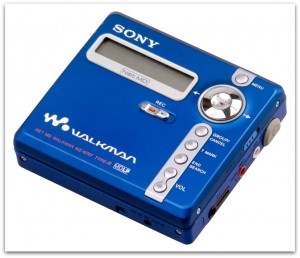Last weekend was “Record Store Day,” an unofficial holiday to get people to buy vinyl albums again. These failed formats probably won’t ever get their own special day.
Minidiscs
 To compete with the compact disc in 1992, Sony introduced the MiniDisc: a three-inch CD housed in a clear plastic case. It combined the sound quality of a CD with the compactness and portability of a cassette. Despite Sony’s huge marketing push on MTV, American consumers didn’t bite—the MiniDisc was perceived as just a miniature CD. Minis also cost $5 more than CDs, and the new player they required cost more than $500. Sony slowly discontinued prerecorded MiniDiscs in the United States, but blank ones were long a popular format for musicians recording demo tapes.
To compete with the compact disc in 1992, Sony introduced the MiniDisc: a three-inch CD housed in a clear plastic case. It combined the sound quality of a CD with the compactness and portability of a cassette. Despite Sony’s huge marketing push on MTV, American consumers didn’t bite—the MiniDisc was perceived as just a miniature CD. Minis also cost $5 more than CDs, and the new player they required cost more than $500. Sony slowly discontinued prerecorded MiniDiscs in the United States, but blank ones were long a popular format for musicians recording demo tapes.
Hiway Hi-Fi
In 1955 Peter Goldmark of CBS Research (part of Columbia Records) came up with a novel way for his company to sell more records: install record players in cars. One obvious problem was how to keep the needle on the record while a car rides along. CBS solved that with a spring-loaded tonearm. Goldmark also devised a disc that had very thin grooves very close together, and played at 16 2⁄3 rpm. It was as small as a 45 rpm record, but played as much music as an LP. The disc was also twice as thick and heavy as a regular record, which helped keep it from bouncing off the turntable. The whole thing was housed in a small, enclosed cabinet mounted under the dash. Columbia talked Chrysler into making the “Hiway Hi-Fi” an option on all new 1956 models, and produced 42 “Hiway” records (mostly classical and Broadway cast albums). But consumers were never convinced that the records would play without skipping. Few buyers selected the Hiway Hi-Fi option, so Chrysler abandoned the concept after just one year.
Digital Compact Cassettes
In 1992 Philips and Matsushita co-developed and introduced Digital Compact Cassettes. The new tapes looked exactly like regular cassette tapes, but the sound quality was far superior—as clear and crisp as a compact disc. Another selling point: DCC players could play regular, older cassettes, so consumers wouldn’t have to replace their music collections. The digital cassettes went nearly completely unnoticed in the United States, where cassette tapes were already considered clunky and obsolete. The format was extremely popular in the Netherlands, but that wasn’t enough to sustain the product. Philips and Matsushita discontinued the DCC in 1996.
This article excerpts “Tech-No”, from Uncle John’s Triumphant 20th Bathroom Reader. Click here to buy!







